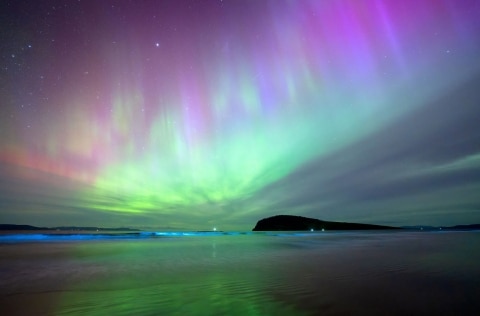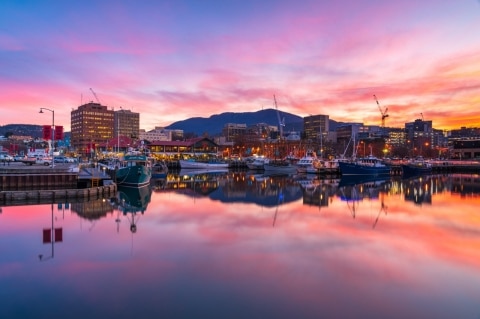24 of the Most Beautiful Natural Wonders to See in Tasmania
Australia's southernmost state is home to some of the country's most incredible natural wonders. Here's our pick of the best places to visit in Tasmania.

The Southern Lights
1/25The Aurora Australis, the southern hemisphere’s answer to the Northern Lights, dances in the dark skies above Tasmania. But the lady, as aurora chasers know the phenomenon, is elusive. You need a clear night with a not-too-bright moon but when she shows herself the aurora is breathtaking. Popular vantage spots include the bays of the South Arm Peninsula, Cradle Mountain, Mount Wellington and South Bruny Island.

Image credit: Jason Charles Hill
Twisted Lakes
2/25In autumn, Twisted Lakes in Cradle Mountain-Lake St Clair National Park are resplendent with amber leaves as the fagus trees start to turn but during the winter months, the scene is more muted – though no less beautiful thanks to the sprinkling of snowflakes on the ground, bare branches and the mossy hues of foliage that can stand the chill.
Image credit: Emilie Ristevski
Pumphouse Point
3/25There’s a stunning spookiness to the vision of Pumphouse Point emerging from the mist on a winter’s day atop Lake St Clair, the deepest lake in the southern hemisphere. The moody moment is best experienced tucked up inside one of the lodge’s cosy rooms (there are six in the land-based Shorehouse and eight in the on-water Pumphouse).
Image credit: Luke Tscharke
Barn Bluff
4/25It might not have the name recognition of Cradle Mountain but Barn Bluff is in fact 14 metres taller than its famous counterpart, and is visible from most parts of the Cradle Mountain-Lake St Clair National Park. It’s often dusted with snow, even in summer – so dress warmly if you’re planning an ascent.
Cradle Mountain
5/25This mountain, rising dramatically from the Tasmanian Wilderness World Heritage Area amid ancient pines and glacial lakes, is a magnet for adventurers – and photographers. The bowed summit is an unusual landform – a nunatak, or an isolated peak that stood above glaciers as they etched the earth around it.
Image credit: Luke Tscharke
Lake Rodway
6/25While hiking to this beautiful spot in the Cradle Mountain-Lake St Clair National Park is generally recommended for the warm months, you can appreciate an aerial vista in winter with a scenic flight over the puzzle-piece-shaped waterway.
Image credit: Tourism Australia / Kathryn Leahy
Tessellated Pavement, Teralina / Eaglehawk Neck
7/25No, it’s not a board game set up long ago and forgotten by ancient giants. The strangely square pools upon the isthmus that joins Tassie’s Forestier and Turrakana / Tasman peninsulas are actually the result of a rare type of erosion. There’s an eerie atmosphere about them at sunrise and the dimming dusk.
Image credit: Tasmania Parks and Wildlife Service
Cape Raoul, Turrakana / Tasman Peninsula
8/25Begin your trek toward the cape’s famed stone columns at the trailhead in Stormlea, a 115-kilometre drive from Hobart. Botanists will get a kick out of the trees changing from stringybark eucalypts to cloud forest then dwarf banksias along the 14-kilometre return trail; anyone will get a thrill walking the cliffside paths.
Image credit: Stu Gibson
Mt Strzelecki, Flinders Island
9/25Summiting this stunning peak on Flinders Island isn’t for the faint of heart – it will take a day to climb the 756-metre-high mountain and make your way back down. But the cardio is worth it: on a blue-sky day, you’ll be able to see across the water to the Tasmanian mainland.
Image credit: Matt Donovan
Wineglass Bay, Freycinet National Park
10/25It’s all about perspective. From a lookout, this spectacular bay on Tasmania’s east coast cuts a sapphire blue curve into rugged bush. Up close, the ‘wineglass’ appears rimmed with golden sand and brims with the kind of turquoise water you’d think was tropical. Find the view on a half-day walk.
Image credit: Getty Images/iStockphoto
Lake Rhona, Franklin-Gordon Wild Rivers National Park
11/25Like a tiny circular sea fringed by quartzite sand and walled by the imposing Denison Ranges, Lake Rhona is a remarkable sight. The lake can only be reached by an overnight hike and you’ll have to wade across the Gordon River (check the conditions first) and clomp through a plain of buttongrass before you get there – but the trek is definitely worth it.
Image credit: Tourism Tasmania/Rob Burnett
Cataract Gorge, Launceston
12/25Walk 15 minutes along the South Esk River from the centre of Launceston city and you’ll come across huge rock cliffs that open into a magnificent gorge and natural basin. The green space is now replete with swim spots, elegant Victorian gardens and a restaurant, as well as raw bushland, wildlife and spectacular views.
Image credit: Tourism Australia / Graham Freeman
Styx Valley
13/25Tassie grows things old and big and at this valley of the giants, a 1.5-hour drive from Hobart, you’ll walk among some of the tallest trees on the planet – including one 84-metre-tall swamp gum called Gandalf’s Staff. A remote place of bright green moss, tangled roots and soaring trunks, it’s easy to imagine the Styx Valley as the woodland home of faeries and sprites.
Image credit: Jason Charles Hill
The Neck, Bruny Island
14/25You’ve probably come for the island’s gourmet reputation but you can’t leave without an eyeful of the isthmus that holds the northern and southern bits of Bruny together. Once you’ve got the classic photograph from the lookout, wander down to the sand – you might spot a pack of fairy penguins waddling along the shoreline.
Image credit: Luke Tscharke
Devils Kitchen and Tasman Arch, Tasman National Park
15/25Nature’s fury and majesty do a dance along an astonishing stretch of coastline south of Pirates Bay. Inside a dramatic 60-metre-deep cauldron of rock, the ocean boils with such aggression that it’s been named Devil’s Kitchen. Meanwhile, a nearby rock formation called Tasman Arch spans the water with natural grace.
Image credit: Getty Images/iStockphoto
Bay of Fires
16/25This picturesque bay was named for the fires belonging to Indigenous people that Captain Tobias Furneaux saw burning along the shore as he sailed in 1773. But you’d be forgiven for guessing it was named for the bright lichen that splatters grey granite rocks along the white sand beach, hedging the sea with blazing orange.
Image credit: Poon Wai Nang
The Nut, Stanley
17/25At the end of splendid Godfreys Beach, right next to the pretty throwback town of Stanley, rises a 143-metre-high, sheer-sided bluff called The Nut. This lonely, odd-looking lump of rock is all that remains of an ancient volcanic plug – the rest eroded away as if it knew it didn’t belong in the otherwise smooth landscape.
Image credit: Tourism Tasmania & Toby Story
Totem Pole, Cape Hauy
18/25It’s 65 metres high, thin as a needle and battered relentlessly by the waves at Cape Hauy on the Turrakana / Tasman Peninsula. But “The Tote” isn’t fragile. This stranded sea stack has made the toughest rock-climbers cry. Simply getting to the base is an epic effort; scaling its height guarantees bragging rights for life. Not up for it? Wave at climbers from the water on a boat or kayak tour instead.
Image credit: Jess Bonde
Trowutta Arch, Trowutta Caves State Reserve
19/25Despite being an easy 10-minute walk through glorious temperate rainforest, this natural wonder remains something of a hidden gem. The archway was formed by sinkholes, which still exist on either side of the fern-covered rock.
Image credit: Alice Hansen
takayna / Tarkine Rainforest, North-west Tasmania
20/25It’s impossible to pinpoint one spot in takayna / Tarkine you should explore; after all, it covers 477,000 hectares of temperate rainforest. There are groves of pine, myrtle and leatherwood; glorious lookouts over the wild expanse; and impressive natural sinkholes that reflect the ancient landscape. First-time visitors will benefit from following the Tarkine Drive to the highlights.
Image credit: We are Explorers
Nelson Falls, Franklin-Gordon Rivers National Park
21/25Though Nelson Falls is one enormous cascade, it splinters off into dozens of trickling waterfalls as it makes its way down the rockface. The boardwalk to get there is only 1.4 kilometres return (most of it is wheelchair accessible) and takes you through cool rainforest and alongside a pretty river.
Image credit: Jess Bonde
Dip Falls, North-west Tasmania
22/25This is a wonder best visited when the sky is gloomy and the heavens have opened: after rain, the two-tiered waterfall is at its most impressive. Combine a day trip here from nearby Stanley with a walk to the Big Tree, an enormous eucalypt almost 17 metres in diameter.
Image credit: Getty Images/Vetta
Ninepin Point Marine Reserve
23/25Snorkelers, suit up. Tasmania is a surprisingly rich seam for underwater adventure and this spot, occupying 731.8 hectares of the D'Entrecasteaux Channel is an aquatic wonderland. Nutrient-rich seawater from the southern ocean mixes with tannin-rich river water, creating a unique environment for an array of red seaweeds, sponge gardens, fish and invertebrates you’d usually have to venture into much deeper water to see.
Image credit: Getty Images/iStockphoto
Three Falls Circuit, Mount Field National Park
24/25This six-kilometre circuit walk in the Derwent Valley region delivers on the promise of its name, taking you from the park’s visitor centre to Russell Falls, Horseshoe Falls and finally, Lady Barron Falls. Along the way you’ll wander through temperate rainforest, encounter geological wonders and see deceptively named swamp gums – the world’s tallest flowering plant.
Image credit: Tourism Tasmania/Popp Hackner Photography
Up Next
25/25














